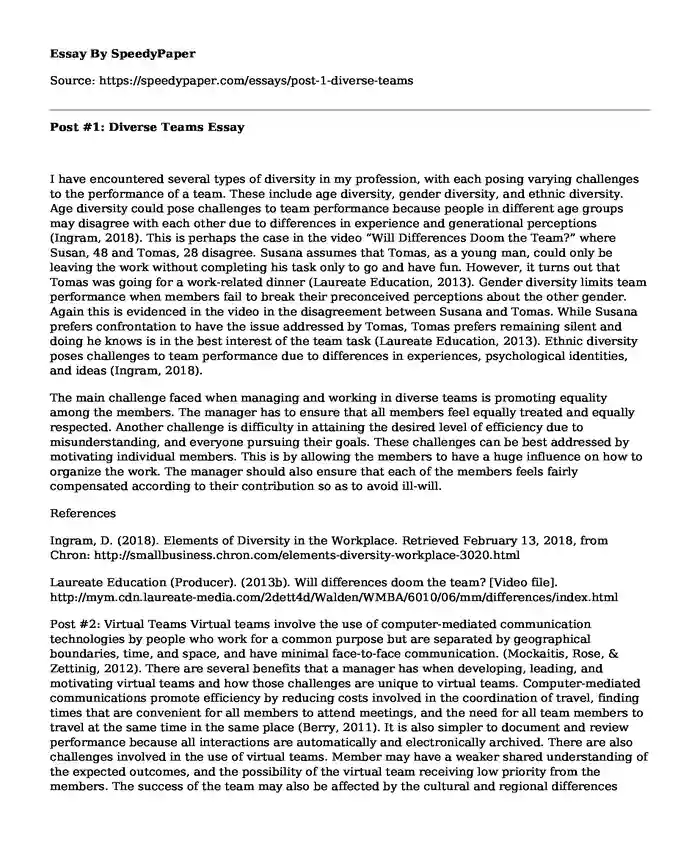
| Type of paper: | Book review |
| Categories: | United States Research Technology |
| Pages: | 3 |
| Wordcount: | 741 words |
I have encountered several types of diversity in my profession, with each posing varying challenges to the performance of a team. These include age diversity, gender diversity, and ethnic diversity. Age diversity could pose challenges to team performance because people in different age groups may disagree with each other due to differences in experience and generational perceptions (Ingram, 2018). This is perhaps the case in the video "Will Differences Doom the Team?" where Susan, 48 and Tomas, 28 disagree. Susana assumes that Tomas, as a young man, could only be leaving the work without completing his task only to go and have fun. However, it turns out that Tomas was going for a work-related dinner (Laureate Education, 2013). Gender diversity limits team performance when members fail to break their preconceived perceptions about the other gender. Again this is evidenced in the video in the disagreement between Susana and Tomas. While Susana prefers confrontation to have the issue addressed by Tomas, Tomas prefers remaining silent and doing he knows is in the best interest of the team task (Laureate Education, 2013). Ethnic diversity poses challenges to team performance due to differences in experiences, psychological identities, and ideas (Ingram, 2018).
The main challenge faced when managing and working in diverse teams is promoting equality among the members. The manager has to ensure that all members feel equally treated and equally respected. Another challenge is difficulty in attaining the desired level of efficiency due to misunderstanding, and everyone pursuing their goals. These challenges can be best addressed by motivating individual members. This is by allowing the members to have a huge influence on how to organize the work. The manager should also ensure that each of the members feels fairly compensated according to their contribution so as to avoid ill-will.
References
Ingram, D. (2018). Elements of Diversity in the Workplace. Retrieved February 13, 2018, from Chron: http://smallbusiness.chron.com/elements-diversity-workplace-3020.html
Laureate Education (Producer). (2013b). Will differences doom the team? [Video file]. http://mym.cdn.laureate-media.com/2dett4d/Walden/WMBA/6010/06/mm/differences/index.html
Post #2: Virtual Teams Virtual teams involve the use of computer-mediated communication technologies by people who work for a common purpose but are separated by geographical boundaries, time, and space, and have minimal face-to-face communication. (Mockaitis, Rose, & Zettinig, 2012). There are several benefits that a manager has when developing, leading, and motivating virtual teams and how those challenges are unique to virtual teams. Computer-mediated communications promote efficiency by reducing costs involved in the coordination of travel, finding times that are convenient for all members to attend meetings, and the need for all team members to travel at the same time in the same place (Berry, 2011). It is also simpler to document and review performance because all interactions are automatically and electronically archived. There are also challenges involved in the use of virtual teams. Member may have a weaker shared understanding of the expected outcomes, and the possibility of the virtual team receiving low priority from the members. The success of the team may also be affected by the cultural and regional differences among the members (Dewar, 2006). These challenges are unique to virtual teams because members have infrequent face-to-face interactions, it is difficult to build a collaborative atmosphere virtually, and virtual team priorities keep changing (Darleen, 2009). Other challenges include social loafing, low commitment from members, and role overload (Mockaitis, Rose, & Zettinig, 2012). The challenges that can be addressed by the leader include weaker share vision of the expected outcomes and cultural and regional differences, but members are supposed to address the challenge of prioritization.
As a manager, I would meet the above challenges in the following ways. First, I would promote effective communication among the team members by balancing the four speech territories, which include framing, advocating, illustrating, and inquiring (Emelo & Francis, 2002). Open and honest communication will also help me shift from promoting task-based trust top interpersonal trust (Darleen, 2009). I will also motivate the members so that they prioritize team tasks and promote a positive and productive environment for all.
References
Berry, G. R. (2011). Enhancing Effectiveness of Virtual Teams: Understanding why Traditional Team Skills are Insufficient. Journal of Business Communication, 48(2), 186-206.
Darleen, D. (2009). Virtual Success: The Keys to Effectiveness in Leading From a Distance. LIA, 28(6), 9-11.
Dewar, T. (2006). Virtual Teams: Virtually Impossible? Performance Improvement, 45(5), 22-25.
Emelo, R., & Francis, L. M. (2002). virtual Team Interaction. Alexandria: Training 101.
Mockaitis, A. I., Rose, E. L., & Zettinig, P. (2012). The Power of Individual Cultural Values in Global Virtual Teams. International Journal of Cross Cultural Management, 1(1), 1-18.
Cite this page
Post #1: Diverse Teams. (2022, Mar 04). Retrieved from https://speedypaper.com/essays/post-1-diverse-teams
Request Removal
If you are the original author of this essay and no longer wish to have it published on the SpeedyPaper website, please click below to request its removal:
- Essay Sample on the Impact on the Children of Syrian Refugee Crisis
- A Spiritual God Creating a Physical Universe and the Universal Laws that Determine Our Lives on Earth
- Free Essay about Nursing Home Administrator Competencies and Skills
- Tax Evasion in Oman, Essay Example for Everyone
- Essay Example: Patient Safety and Patient Satisfaction in Hospitals
- Essay Sample on Sexual Harassment in Ford Motor Company
- Future of American Society - Free Paper Sample
Popular categories




